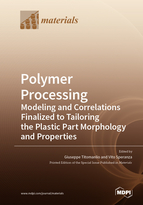Polymer Processing: Modeling and Correlations Finalized to Tailoring the Plastic Part Morphology and Properties
A special issue of Materials (ISSN 1996-1944).
Deadline for manuscript submissions: closed (31 January 2019) | Viewed by 75510
Special Issue Editors
Interests: polymer processing; flow-induced crystallization and effect of crystallinity on rheology; morphology evolution during polymer processing; injection molding simulation
Special Issues, Collections and Topics in MDPI journals
Interests: molding; effect of thermomechanical history on final structure of polymeric materials; analysis and numerical simulation of the injection molding process of thermoplastic materials; polymeric materials characterization; atomic force microscopy
Special Issues, Collections and Topics in MDPI journals
Special Issue Information
Dear Colleagues,
The analysis of polymer processing operations is a very wide and complex subject; indeed, during polymer processing, viscoelastic fluids are forced to deform into desired geometries using non-homogeneous velocity and temperature fields down to solidification. The objective of analysis is certainly the identification of processing conditions, which, more and more, are finalized to the optimization of product final properties, which, in their turn, are determined by the final part morphology.
Depending on the operating conditions, the properties of the final part can change even more than one order of magnitude. Properties of interest are certainly the mechanical, optical, barrier properties, the permeability, biodegradability and any other property of practical relevance including the characteristics of the surfaces as its finishing and wettability, which are connected one to the other.
The aim of this Special Issue is to select progresses or reviews in the understanding/description of the phenomena involved along the chain: Processing–morphology–properties. Obviously, along this virtual chain, the modeling may be a very useful approach and within the objective of understanding fundamental aspects it may also be relevant to compare selected characteristics of the process and of the material with characteristics of the resulting morphology and then with the properties of the final part. This approach suggested the title: “Polymer Processing: Modeling and Correlations Finalized to Tailoring the Plastic Part Morphology and Properties”.
Prof. Dr. Giuseppe Titomanlio
Dr. Vito Speranza
Guest Editors
Manuscript Submission Information
Manuscripts should be submitted online at www.mdpi.com by registering and logging in to this website. Once you are registered, click here to go to the submission form. Manuscripts can be submitted until the deadline. All submissions that pass pre-check are peer-reviewed. Accepted papers will be published continuously in the journal (as soon as accepted) and will be listed together on the special issue website. Research articles, review articles as well as short communications are invited. For planned papers, a title and short abstract (about 100 words) can be sent to the Editorial Office for announcement on this website.
Submitted manuscripts should not have been published previously, nor be under consideration for publication elsewhere (except conference proceedings papers). All manuscripts are thoroughly refereed through a single-blind peer-review process. A guide for authors and other relevant information for submission of manuscripts is available on the Instructions for Authors page. Materials is an international peer-reviewed open access semimonthly journal published by MDPI.
Please visit the Instructions for Authors page before submitting a manuscript. The Article Processing Charge (APC) for publication in this open access journal is 2600 CHF (Swiss Francs). Submitted papers should be well formatted and use good English. Authors may use MDPI's English editing service prior to publication or during author revisions.
Keywords
- polymer processing
- modeling morphology evolution
- morphology of polymeric parts in relation to their processing
- morphology-properties relationships of polymeric parts
- polymeric part properties








